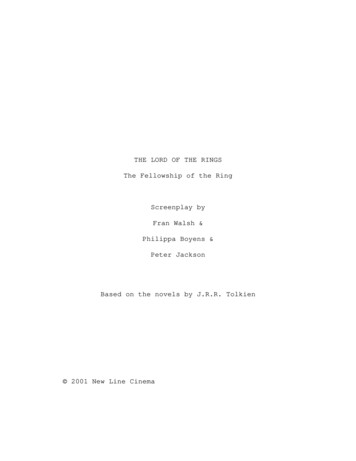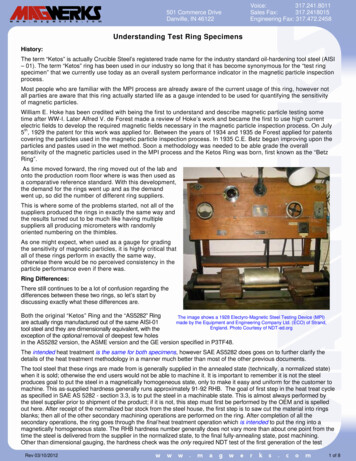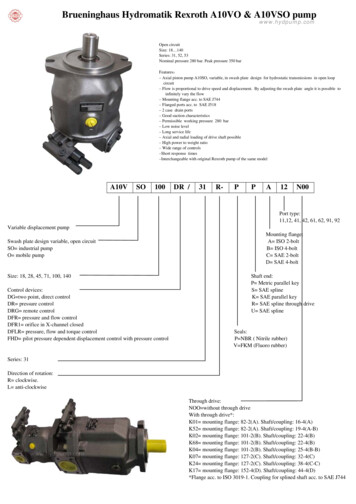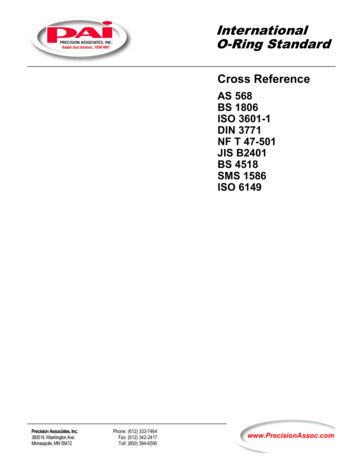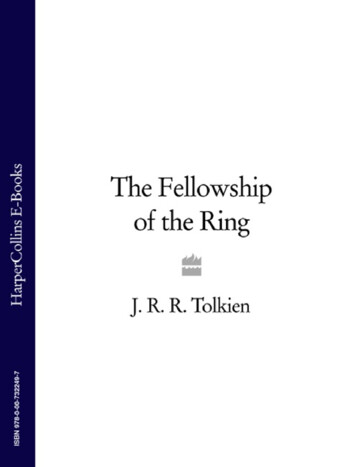
Transcription
THEFELLOWSHIP
OF THERING
BEING THE FIRST PART OFTHE LORD OF THERINGSBYJ.R.R. TOLKIEN
Three Rings for the Elvenkings under the sky,Seven for the Dwarf-lordsin their halls of stone,Nine for Mortal Men doomedto die,One for the Dark Lord onhis dark throneIn the Land of Mordor wherethe Shadows lie.One Ring to rule them all,
One Ring to find them,One Ring to bring them alland in the darkness bindthemIn the Land of Mordor wherethe Shadows lie.
CONTENTSCOVER PAGETITLE PAGENOTE ON THE TEXTNOTE ON THE 50THANNIVERSARY EDITIONFOREWORD TO THESECOND EDITION
PROLOGUEBOOK ONECHAPTER 1: A LONGEXPECTED PARTYCHAPTER 2: THESHADOW OF THE PASTCHAPTER 3: THREE ISCOMPANYCHAPTER 4: A SHORTCUT TO MUSHROOMS
CHAPTER 5: ACONSPIRACYUNMASKEDCHAPTER 6: THE OLDFORESTCHAPTER 7: IN THEHOUSE OF TOMBOMBADILCHAPTER 8: FOG ON THEBARROW-DOWNSCHAPTER 9: AT THE SIGN
OF THE PRANCING PONYCHAPTER 10: STRIDERCHAPTER 11: A KNIFE INTHE DARKCHAPTER 12: FLIGHT TOTHE FORDBOOK TWOCHAPTER 1: MANYMEETINGSCHAPTER 2: THE
COUNCIL OF ELRONDCHAPTER 3: THE RINGGOES SOUTHCHAPTER 4: A JOURNEYIN THE DARKCHAPTER 5: THE BRIDGEOF KHAZAD-DÛMCHAPTER 6:LOTHLÓRIENCHAPTER 7: THE MIRROROF GALADRIEL
CHAPTER 8: FAREWELLTO LÓRIENCHAPTER 9: THE GREATRIVERCHAPTER 10: THEBREAKING OF THEFELLOWSHIPMAPWORKS BY J.R.R.TOLKIENCOPYRIGHT
ABOUT THE PUBLISHER
NOTE ON THETEXTJ.R.R. Tolkien’s The Lord ofthe Rings is often erroneously
called a trilogy, when it is infact a single novel, consistingof six books plus appendices,sometimes published in threevolumes.The first volume, TheFellowship of the Ring, waspublished in Great Britain bythe London firm GeorgeAllen & Unwin on 29 July1954; an American editionfollowed on 21 October of thesame year, published by
Houghton Mifflin Companyof Boston. In the productionof this first volume, Tolkienexperienced what became forhim a continual problem:printer’s errors andcompositor’s mistakes,including well-intentioned‘corrections’ of hissometimes idiosyncraticusage. These ‘corrections’include the altering ofdwarves to dwarfs, elvish to
elfish, further to farther,nasturtians to nasturtiums,try and say to try to say and(‘worst of all’ to Tolkien)elven to elfin. In a work suchas The Lord of the Rings,containing inventedlanguages and delicatelyconstructed nomenclatures,errors and inconsistenciesimpede both theunderstanding and theappreciation of serious
readers – and Tolkien hadmany such readers from veryearly on. Even before thepublication of the thirdvolume, which containedmuch hitherto unrevealedinformation on the inventedlanguages and writingsystems, Tolkien receivedmany letters from readerswritten in these systems, inaddition to numerousenquiries on the finer points
of their usage.The second volume, TheTwo Towers, was publishedin England on 11 November1954 and in the United Stateson 21 April 1955. MeanwhileTolkien worked to keep apromise he had made in theforeword to volume one: that‘an index of names andstrange words’ would appearin the third volume. Asoriginally planned, this index
would contain muchetymological information onthe languages, particularly onthe elven tongues, with alarge vocabulary. It provedthe chief cause of the delay inpublishing volume three,which in the end contained noindex at all, only an apologyfrom the publisher for itsabsence. For Tolkien hadabandoned work on it afterindexing volumes one and
two, believing its size andtherefore its cost to beruinous.Volume three, The Returnof the King, finally appearedin England on 20 October1955 and in the United Stateson 5 January 1956. With theappearance of the thirdvolume, The Lord of theRings was published in itsentirety, and its first editiontext remained virtually
unchanged for a decade.Tolkien had made a few smallcorrections, but further errorsentered The Fellowship of theRing in its December 1954second impression when theprinter, having distributed thetype after the first printing,reset the book withoutinforming the author orpublisher. These includemisrepresentations of theoriginal printed text – that is,
words and phrases that readacceptably in context, butwhich depart from Tolkien’swording as originally writtenand published.In 1965, stemming fromwhat then appeared to becopyright problems in theUnited States, an Americanpaperback firm published anunauthorized and nonroyalty-paying edition of TheLord of the Rings. For this
new edition by Ace Books thetext of the narrative was reset,thus introducing newtypographical errors; theappendices, however, werereproduced photographicallyfrom the hardcover edition,and remain consistent with it.Tolkien set to work on hisfirst revision of the text sothat a newly revised andauthorized edition couldsuccessfully compete on the
American market. This firstrevision of the text waspublished in America inpaperback by BallantineBooks, under licence fromHoughton Mifflin, in October1965. In addition to revisionswithin the text itself, Tolkienreplaced his original forewordwith a new one. He waspleased to remove theoriginal foreword; in hischeck copy, he wrote of it:
‘confusing (as it does) realpersonal matters with the“machinery” of the Tale, is aserious mistake’. Tolkien alsoadded an extension to theprologue and an index – notthe detailed index of namespromised in the first edition,but, rather, a bald index withonly names and pagereferences. Additionally, atthis time the appendices weregreatly revised.
Tolkien received hiscopies of the Ballantineedition in late January 1966,and in early February herecorded in his diary that hehad ‘worked for some hourson the Appendices inBallantine version & foundmore errors than I at firstexpected’. Soon after this hesent a small number of furtherrevisions to Ballantine for theappendices, including the
now well-known addition of‘Estella Bolger’ as wife ofMeriadoc in the family treesin Appendix C. Most of theserevisions, which enteredvariously in the third andfourth impressions ( June andAugust 1966) of volumethree, and which were notalways inserted correctly(thereby causing furtherconfusion in the text),somehow never made it into
the main sequence of revisionin the three-volume Britishhardcover edition, and forlong remained anomalies.Tolkien once wrote,concerning the revising ofThe Lord of the Rings, thatperhaps he had failed to keephis notes in order; this errantbranch of revision seemslikely to be an example ofthat disorder – either in hisnotes or in the ability of his
publishers to follow themwith utmost accuracy.The revised text firstappeared in Great Britain in athree-volume hardcover‘Second Edition’ from Allen& Unwin on 27 October1966. But again there wereproblems. Although therevisions Tolkien sent toAmerica of the text itselfwere available to be utilizedin the new British edition, his
extensive revisions to theappendices were lost afterbeing entered into theBallantine edition. Allen &Unwin were forced to resetthe appendices using the copyas published in the firstBallantine edition. This didnot include Tolkien’s second,small set of revisions sent toBallantine; but, moresignificantly, it did include agreat number of errors and
omissions, many of whichwere not discovered untillong afterwards. Thus, in theappendices, a close scrutinyof the first edition text and ofthe much later correctedimpressions of the secondedition is necessary to discernwhether any particular changein this edition is authorial orerroneous.In America, the revisedtext appeared in hardcover in
the three-volume editionpublished by HoughtonMifflin on 27 February 1967.This text was evidentlyphoto-offset from the 1966Allen & Unwin three-volumehardcover, and is thusconsistent with it. Aside fromthe first printing of thissecond Houghton Mifflinedition, which has a 1967date on the title page, none ofthe many reprintings is dated.
After the initial printings ofthis edition, which bore a1966 copyright notice, thedate of copyright waschanged in 1965 to match thestatement in the Ballantineedition. This change hascaused a great deal ofconfusion for librarians andother researchers who havetried to sort out the sequenceof publication of theseeditions.
Meanwhile, Tolkien spentmuch of the summer of 1966further revising the text. InJune he learned that any morerevisions were too late forinclusion in the 1966 Allen &Unwin second edition, and herecorded in his diary: ‘But Iam attempting to completemy work [on the revisions] –I cannot leave it while it is allin my mind. So much timehas been wasted in all my
work by this constantbreaking of threads.’ Thiswas the last major set ofrevisions Tolkien himselfmade to the text during hislifetime. They were added tothe second impression (1967)of the three-volume hardcover Allen & Unwin secondedition. The revisionsthemselves mostly includecorrections of nomenclatureand attempts at consistency of
usage throughout the threevolumes. Some smallalterations were made byTolkien in the 1969 onevolume India paper edition.J.R.R. Tolkien died in1973. His third son andliterary executor, ChristopherTolkien, sent a large numberof further corrections ofmisprints, mainly in theappendices and index, toAllen & Unwin for use in
their editions in 1974. Mostof these corrections weretypographical, and in linewith his father’s expressedintent in his own checkcopies.Since 1974, ChristopherTolkien has sent additionalcorrections, as errors havebeen discovered, to theBritish publishers of TheLord of the Rings (Allen &Unwin, later Unwin Hyman,
and now HarperCollins), whohave tried to be conscientiousin the impossible task ofmaintaining a textual integrityin whichever editions of TheLord of the Rings they havepublished. However, everytime the text has been resetfor publication in a newformat (e.g. the variouspaperback editions publishedin England in the 1970s and1980s), huge numbers of new
misprints have crept in,though at times some of theseerrors have been observedand corrected in laterprintings. Still, throughoutthese years the three-volumeBritish hardcover edition hasretained the highest textualintegrity.In the United States, thetext of the Ballantinepaperback has remainedunchanged for more than
three decades after Tolkienadded his few revisions in1966. The text in all of theHoughton Mifflin editionsremained unchanged from1967 until 1987, whenHoughton Mifflin photooffset the then current threevolume British hardcoveredition in order to update thetext used in their editions. Inthose new reprintings anumber of further corrections
(overseen by ChristopherTolkien) were added, and theerrant Ballantine branch ofrevision (including the‘Estella Bolger’ addition) wasintegrated into the mainbranch of textual descent.This method of correctioninvolved a cut-and-pasteprocess with printed versionsof the text. Beginning withthe 1987 Houghton Mifflinedition, an earlier version of
this ‘Note on the Text’ (datedOctober 1986) was added toThe Lord of the Rings. This‘Note’ has been reworkedthree times since then – theversion dated April 1993 firstappeared in 1994, and theversion dated April 2002came out later that year. Thepresent ‘Note’ replaces andsupersedes all previousversions.For the 1994 British
edition published byHarperCollins, the text of TheLord of the Rings was enteredinto word-processing files.This next stage of textualevolution came about toallow for a greater uniformityof the text in all futureeditions, but with it,inevitably, came newwrinkles. Some newmisreadings entered into thetext, while at the same time
others were fixed. In theworst instance, one line of thering inscription in the chapter‘The Shadow of the Past’ ofThe Fellowship of the Ringwas simply dropped.Unforeseeable glitches arosein other editions when thebase computerized text wastransferred into page-makingor typesetting programs –e.g., in one edition of TheFellowship of the Ring, the
closing two sentences of ‘TheCouncil of Elrond’ simplyand inexplicably disappeared.Such glitches have been verymuch the exception, not therule, and the text hasotherwise maintained aconsistency and integritythroughout its computerizedevolution.The 1994 edition alsocontained a number of newcorrections (again supervised
by Christopher Tolkien), aswell as a reconfigured indexof names and page references.The 1994 text was first usedin American editionspublished by HoughtonMifflin in 1999. A smallnumber of further correctionswere added into the 2002three-volume editionillustrated by Alan Lee,published by HarperCollins inGreat Britain and Houghton
Mifflin in the United States.The textual history of TheLord of the Rings, merely inits published form, is a vastand complex web. In thisbrief note I have given only aglimpse of the overallsequence and structure.Further details on therevisions and correctionsmade over the years to the
published text of The Lord ofthe Rings, and a fulleraccount of its publishinghistory, may be found inJ.R.R. Tolkien: A DescriptiveBibliography, by Wayne G.Hammond, with theassistance of Douglas A.Anderson (1993).For those interested inobserving the gradualevolving of The Lord of theRings from its earliest drafts
to its published form, I highlyrecommend ChristopherTolkien’s account, whichappears within five volumesof his twelve-volume seriesThe History of Middle-earth.Volumes six through ninecontain the major part of hisstudy pertaining to The Lordof the Rings: The Return ofthe Shadow (1988); TheTreason ofIsengard (1989);The War of the Ring (1990);
and Sauron Defeated (1992).Also, the final book of theseries, The Peoples ofMiddle-earth (1996), coversthe evolution of the prologueand appendices to The Lordof the Rings. These volumescontain an engrossing overthe-shoulder account of thegrowth and writing ofTolkien’s masterpiece.The process of studyingTolkien’s manuscripts of The
Lord of the Rings involvedthe deciphering of versionswhere Tolkien wrote first inpencil and then in ink atopthe pencilled draft.Christopher Tolkien hasdecribed his father’s methodof composition in The Returnof the Shadow: ‘In thehandwriting that he used forrapid drafts and sketches, notintended to endure longbefore he turned to them
again and gave them a moreworkable form, letters are soloosely formed that a wordwhich cannot be deduced orguessed at from the context orfrom later versions can proveperfectly opaque after longexamination; and if, as heoften did, he used a softpencil much has now becomeblurred and faint.’ The truedifficulty of reading suchdouble-drafts can be observed
in the frontispiece to The Warof the Ring, which reproducesin colour Tolkien’sillustration of ‘Shelob’s Lair’from a page of Tolkien’smanuscript. Looking veryclosely at the hasty ink draftalongside the illustration, onecan see underneath it theearlier, hastier, pencilleddraft. Also in The War of theRing, Christopher Tolkienreproduces a page from the
first manuscript of the chapter‘The Taming of Sméagol’,and the printed textcorresponding to this text ison the facing page (see pp.90–91). One is astonished atanyone’s ability to deciphersuch texts.That difficulty aside, justwhat do these books signifyto ordinary readers and toTolkien scholars? And whatis ‘the history of the writing’
of a book? Simply, thesevolumes show in great detailthe development of the storyof The Lord of the Rings fromits very earliest drafts andhasty projections through itscompletion. We see in theearliest materials what is verymuch a children’s book, asequel to The Hobbit, and asthe story grows throughvarious ‘phases’, there is anincrease in seriousness and
depth. We see alternatebranches of development, thegradual blending and mergingof certain characters, and theslow emergence of the natureof the rings and of themotivations of othercharacters. Some of thesevarious ideas are abandonedaltogether, while others arereworked into some variantform that may or may notsurvive into the final version.
One could make a wholecatalogue of interestingtidbits from ChristopherTolkien’s study – such as thefact that Strider was calledTrotter until a very late stagein the writing of the book;that Trotter was at one time ahobbit, so named because hewore wooden shoes; thatTolkien at one pointconsidered a romancebetween Aragorn and Éowyn;
that Tolkien wrote anepilogue to the book, tying uploose ends, but it wasdropped before publication(and now appears in SauronDefeated); and so on. Butthese developments are bestappreciated when read withinthe context of ChristopherTolkien’s commentary ratherthan discussed separately.The most significantachievement of these volumes
is that they show us howTolkien wrote and thought.Nowhere else do we see theauthorial process itself atwork in such detail. Tolkien’shastiest comments aboutwhere the story mightproceed, or why it can orcan’t go such and such a way– these queries to himselfwere written out: Tolkien isliterally thinking on paper.This gives an added
dimension of understandingto Tolkien’s comment toStanley Unwin in a 1963letter that, when sufferingfrom trouble with hisshoulder and right arm, ‘Ifound not being able to use apen or pencil as defeating asthe loss of her beak would beto a hen.’ And we, as readersof these volumes, can sharewith Tolkien himself thewonder and bewilderment of
new characters appearing asif from nowhere, or of someother sudden change ordevelopment, at the verymoment of their emergenceinto the story.I know of no otherinstance in literature wherewe have such a ‘history of thewriting’ of a book, toldmostly by the author himself,with all the hesitations andfalse paths laid out before us,
sorted out, commented upon,and served up to a reader likea feast. We are showninnumerable instances in theminutest detail of thethought-process itself atwork. We see the author fullyabsorbed in creation for itsown sake. And this is all themore exceptional because thisis a history not only of theunfolding of a story and itstext, but of the evolution of a
world. There is an additionalwealth of material beyondsimple narrative text. Thereare maps and illustrations.There are languages andwriting systems, and thehistories of the peoples whospoke and wrote in thesesystems. All of theseadditional materials addmultiple dimensions ofcomplexity to ourappreciation of the invented
world itself.Fifty years into thepublished life of The Lord ofthe Rings, it seemsextraordinary to me that wehave not only such amasterful work of literaturebut also as a companion to itan unparalleled account of itswriting. Our gratitude asreaders goes to both of theTolkiens, father and son.
Douglas A. AndersonMay 2004
NOTE ON THE 50THANNIVERSARYEDITION
In this edition of The Lord ofthe Rings, prepared for thefiftieth anniversary of itspublication, between threeand four hundredemendations have been madefollowing an exhaustivereview of past editions andprintings. The present text isbased on the setting of theHarperCollins three-volumehardcover edition of 2002,which in turn was a revision
of the HarperCollins resetedition of 1994. As DouglasA. Anderson comments in thepreceding ‘Note on the Text’,each of those editions wasitself corrected, and each alsointroduced new errors. At thesame time, other errorssurvived undetected, amongthem some five dozen whichentered as long ago as 1954,in the resetting of TheFellowship of the Ring
published as its ‘secondimpression’.That the printer hadquietly reset The Fellowshipof the Ring, and that copieshad been issued without proofhaving been read by theauthor, never became knownto Tolkien; while hispublisher, Rayner Unwin,learned of it only thirty-eightyears after the fact. Tolkienfound a few of the
unauthorized changesintroduced in the secondprinting when (probablywhile preparing the secondedition in 1965) he read acopy of the twelfthimpression (1962), butthought the errors newlymade. These, among others,were corrected in the courseof the reprinting. Then in1992 Eric Thompson, areader with a keen eye for
typographic detail, noticedsmall differences between thefirst and second impressionsof The Fellowship of the Ringand called them to theattention of the presenteditors. About one-sixth ofthe errors that entered in thesecond printing quickly cameto light. Many more wererevealed only recently, whenSteven M. Frisby usedingenious optical aids to
make a comparison of copiesof The Lord of the Rings ingreater detail than waspreviously accomplished. Wehave gladly made full use ofMr Frisby’s results, which hehas generously shared anddiscussed.In the course of its fiftyyear history The Lord of theRings has had many suchreaders who have recordedchanges made between its
various appearances in print,both to document what hasgone before and to aid in theachievement of anauthoritative text. Errors orpossible errors were reportedto the author himself or to hispublishers, and informationon the textual history of thework circulated amongTolkien enthusiasts at least asearly as 1966, when BanksMebane published his
‘Prolegomena to a VariorumTolkien’ in the fanzineEntmoot. Most notably inlater years, Douglas A.Anderson has been in theforefront of efforts to achievean accurate text of The Lordof the Rings (and of TheHobbit); Christina Scull haspublished ‘A PreliminaryStudy of Variations inEditions of The Lord of theRings’ in Beyond Bree (April
and August 1985); Wayne G.Hammond has compiledextensive lists of textualchanges in J.R.R. Tolkien: ADescriptive Bibliography(1993); and David Bratmanhas published an importantarticle, ‘A Corrigenda to TheLord of the Rings’, in theMarch 1994 number of TheTolkien Collector. Theobservations of DainisBisenieks, Yuval Welis,
Charles Noad, and otherreaders, sent to us directly orposted in public forums, havealso been of service.Efforts such as thesefollow the example of theauthor of The Lord of theRings during his lifetime. Hisconcern for the textualaccuracy and coherence of hiswork is evident from themany emendations he madein later printings, and from
notes he made for otheremendations which for onereason or another have notpreviously (or have onlypartly) been put into effect.Even late in life, when suchlabours wearied him, hisfeelings were clear. On 30October 1967 he wrote to JoyHill at George Allen &Unwin, concerning a reader’squery he had received aboutpoints in the Appendices to
The Lord of the Rings:‘Personally I have ceased tobother about these minor“discrepancies”, since if thegenealogies and calendarsetc. lack verisimilitude it is intheir general excessiveaccuracy: as compared withreal annals or genealogies!Anyway the slips were few,have now mostly beenremoved, and the discoveryof what remain seems an
amusing pastime! But errorsin the text are another matter’(italics ours). In fact Tolkienhad not ‘ceased to bother’,and ‘slips’ were dealt with asopportunities arose. These,and the indulgence of hispublisher, allowed Tolkien aluxury few authors enjoy:multiple chances not only tocorrect his text but to improveit, and to further develop thelanguages, geography, and
peoples of Middle-earth.The fiftieth anniversary ofThe Lord of the Rings seemedan ideal opportunity toconsider the latest (2002) textin light of information we hadgathered in the course ofdecades of work in Tolkienstudies, with Steve Frisby’sresearch at hand, and with anelectronic copy of The Lordof the Rings (supplied byHarperCollins) searchable by
keyword or phrase. The latterespecially allowed us todevelop lists of words thatvaried from one instance toanother, and investigatevariations in usage, as theystood in the copy-text andrelative to earlier editions andprintings. Of course Tolkienwrote The Lord of the Ringsover so long a period of time,some eighteen years, thatinconsistencies in its text
were almost inevitable.Christopher Tolkien evenobserved to us that someapparent inconsistencies ofform in his father’s work mayeven have been deliberate: forinstance, although Tolkiencarefully distinguished house‘dwelling’ from House ‘noblefamily or dynasty’, in twoinstances he used house in thelatter sense but in lower case,perhaps because a capital
letter would have detractedfrom the importance of theadjective with which theword was paired (‘royalhouse’, ‘golden house’).There can be no doubt,however, that Tolkienattempted to correctinconsistency, no less thanoutright error, whenever itcame to his attention, and itwas our opinion, with theadvice and agreement of
Christopher Tolkien, that anattempt should be made to doso in the anniversary edition,in so far as we could carefullyand conservativelydistinguish what to emend.Many of the emendationsin the present text are tomarks of punctuation, eitherto correct recenttypographical errors or torepair surviving alterationsintroduced in the second
printing of The Fellowship ofthe Ring. In the latter respectand in every case, Tolkien’soriginal punctuation is alwaysmore felicitous – subtlepoints, when one iscomparing commas and semicolons, but no less a part ofthe author’s intendedexpression. Distinctive wordssuch as chill rather than cold,and glistered rather thanglistened, changed by
typesetters long ago withoutauthorization, likewise havebeen restored. A controlledamount of regularization alsoseemed called for, such asnaught rather than nought, achange instituted by Tolkienbut not carried through in allinstances; Dark Power ratherthan dark power when thereference is obviously toSauron (or Morgoth);Barrow-downs by Tolkien’s
preference rather thanBarrowdowns; likewise Breehill rather than Bree Hill;accented and more commonDrúadan rather thanDruadan; capitalized namesof seasons when used aspersonification or metaphor,according to Tolkien’spredominant practice and theinternal logic of the text; andElvish rather than elvish whenused as a separate adjective,
following a preferenceTolkien marked in his copy ofthe second edition of TheLord of the Rings. In addition,we have added a secondaccent to Númenórean(s), asTolkien often wrote the namein manuscript and as itappears in The Silmarillionand other posthumouspublications.The result, nonetheless,still includes many variations
in capitalization, punctuation,and other points of style. Notall of these are erroneous:they include words such asSun, Moon, Hobbit, and Man(or sun, moon, hobbit, man),which may change formaccording to meaning orapplication, in relation toadjacent adjectives, orwhether Tolkien intendedpersonification, poetry, oremphasis. His intent cannot
be divined with confidence inevery case. But it is possibleto discern Tolkien’spreferences in manyinstances, from statements hewrote in his check copies ofThe Lord of the Rings or froma close analysis of its text inmanuscript, typescript, proof,and print. Whenever there hasbeen any doubt whatsoever asto the author’s intentions, thetext has been allowed to
stand.Most of the demonstrableerrors noted by ChristopherTolkien in The History ofMiddle-earth also have beencorrected, such as thedistance from the BrandywineBridge to the Ferry ( tenmiles rather than twenty) andthe number of Merry’s ponies( five rather than six),shadows of earlier drafts. Butthose inconsistencies of
content, such as Gimli’sfamous (and erroneous)statement in Book III,Chapter 7, ‘Till now I havehewn naught but wood since Ileft Moria’, which wouldrequire rewriting to emendrather than simple correction,remain unchanged.So many new emendationsto The Lord of the Rings, andsuch an extensive review ofits text, deserve to be fully
documented. Although mostreaders will be content withthe text alone, many willwant to know more about theproblems encountered inpreparing this new edition,and their solutions (wheresolutions have been possible),especially where the text hasbeen emended, but also whereit has not. To this end, and toilluminate the work in otherrespects, we are preparing a
volume of annotations to TheLord of the Rings forpublication in 2005. This willallow us to discuss, at alength impossible in aprefatory note, the varioustextual cruces of The Lord ofthe Rings, to identify changesthat have been made to thepresent text, and to remark onsignificant alterations to thepublished work throughout itshistory. We will also explain
archaic or unusual words andnames in The Lord of theRings, explore literary andhistorical influences, noteconnections with Tolkien’sother writings, and commenton differences between itsdrafts and published form, onquestions of language, and onmuch else that we hope willinterest readers and enhancetheir enjoyment of Tolkien’smasterpiece.
Wayne G. Hammond &Christina ScullMay 2004
FOREWORD TOTHE SECONDEDITION
This tale grew in the telling,until it became a history ofthe Great War of the Ringand included many glimpsesof the yet more ancienthistory that preceded it. Itwas begun soon after TheHobbit was written andbefore its publication in 1937;but I did not go on with thissequel, for I wished first tocomplete and set in order themythology and legends of the
Elder Days, which had thenbeen taking shape for someyears. I desired to do this formy own satisfaction, and Ihad little hope that otherpeople would be interested inthis work, especially since itwas primarily linguistic ininspiration and was begun inorder to provide the necessarybackground of ‘history’ forElvish tongues.When those whose advice
and opinion I soughtcorrected little hope to nohope, I went back to thesequel, encouraged byrequests from readers formore information concerninghobbits and their adventures.But the story was drawnirresistibly towards the olderworld, and became anaccount, as it were, of its endand passing away before itsbeginning and middle had
been told. The process hadbegun in the writing of TheHobbit, in which there werealready some references tothe older matter: Elrond,Gondolin, the High-elves, andthe orcs, as well as
J.R.R. Tolkien’s The Lord of the Rings is often erroneously. called a trilogy, when it is in fact a single novel, consisting of six books plus appendices, sometimes published in three volumes. The fir
